
Small hands love to explore, and that sense of curiosity can be nerve-wracking for parents when electrical outlets and cords enter the picture. It’s tough to keep an eye on little ones every minute of the day, so setting up a safer environment can ease your worries and reduce the chance of accidents.
Wires that dangle from countertops or exposed power strips might look innocent, but they’re a magnet for children eager to tug and poke. The good news is that a few straightforward precautions can go a long way in lowering risks.
This guide offers tips for organizing your space, securing wires, and performing routine inspections. The focus is on making smart changes that still allow your household to function smoothly.
After all, no one wants to feel like they’re living in a fortress of childproof locks and barriers. Instead, think of it as designing a home that fosters your child’s sense of wonder while ensuring they can’t easily access dangerous electrical components.
Common Electrical Dangers for Young Children

Electronics and electricity are woven into everyday life, which means potential risks lurk in places many adults don’t even notice.
Outlets are one of the biggest draws for curious toddlers, especially if they can reach them or see something spark when a plug is inserted. Damaged or frayed wires pose another threat, and so do power strips overloaded with multiple devices. One accidental tug could pull down lamps or cause short circuits.
Parents might overlook older, faulty appliances tucked away in basements or garages. Even if you rarely use them, that single moment when a child manages to switch one on could lead to a scare.
Electrical safety isn’t something to overlook. Tragedies can occur because adults assume “it won’t happen here.” Taking just a few minutes to evaluate your home can prevent bigger issues down the line.
Key Tips for Childproofing Electrical Outlets and Appliances
Protecting outlets is one of the easiest steps you can take to keep young children safe. Blank covers and plug-in caps are widely available and usually affordable. They’re simple to install and remove for adults but present a challenge for toddlers lacking finger dexterity. Some families opt for tamper-resistant receptacles, which include built-in covers that only open when a plug prong is inserted with equal pressure on both sides.
Appliances deserve attention as well. If you’re using older devices, check them for exposed wiring or cracked plastic. Replace anything that appears questionable. If a piece of equipment has an on/off switch that’s easy to reach, stow it on a high shelf or unplug it when not in use. Even a toaster or hair dryer becomes less of a threat if curious kids can’t access it.
A thorough approach helps reinforce a child’s safety in many areas, which is why you should kid-proof your entire home. Children often gravitate toward objects that catch their eye, so minimizing obvious hazards is a big step in childproofing.
Managing Cords and Power Strips for Child Safety

Cords might seem harmless, but they’re surprisingly tempting for young kids who see them as something to yank or chew on. It’s a good idea to tuck cords behind furniture, use cable ties, or invest in cord management sleeves that bundle wires together. Securing them to walls or baseboards can also keep them out of reach.
Power strips are another area to address. Overloading them not only creates a fire hazard, it also offers more cords for small hands to pull. Where possible, keep power strips behind furniture.
Some models include covers or child safety features. However, if you’re ever unsure about the best way to label or group wires, you can always refer back to the wiring color codes. They will help you organize your setup and ensure everything is connected securely. Surge protectors with built-in safety measures can limit the damage from power fluctuations and keep your devices — and your family — safer.
Conducting Regular Safety Checks
It’s easy to forget maintenance tasks until something goes wrong. Fortunately, a periodic review of your home’s electrical systems doesn’t need to be time-consuming.
Checking for loose outlet covers, testing GFCI (ground-fault circuit interrupter) outlets in bathrooms or kitchens, and scanning for worn cords can be part of a monthly or quarterly chore list. Consider putting together or using an electrical safety and performance checklist to help walk you through key inspections. This includes outlets, cords, and appliances, which are all spots that curious children might touch.
One tip is to turn off and unplug appliances that aren’t regularly used, since leaving them plugged in creates both an energy drain and a possible hazard for toddlers exploring off-limits areas. You can also test your smoke detectors and carbon monoxide alarms while you’re at it. It’s better to be proactive now than scramble in a panic later.
Conclusion
Childproofing your home doesn’t mean sacrificing normal routines or turning the living room into a maze of gates. It’s about making deliberate choices to hide or secure cables, cover unused outlets, and fix anything that poses a risk.
Kids grow and become more curious day by day, so it’s wise to reevaluate your home setup every few months. A cord that used to hang above their reach might be within grasp after a growth spurt.
Being mindful of electrical safety is one way to protect your family’s well-being and give you peace of mind. Minor adjustments can lower the chance of accidental shocks or other injuries. Keeping up with routine checks and simple fixes is a powerful way to encourage exploration while making sure your child’s daily adventures stay safe.
